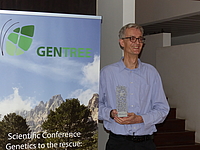GenTree partners discussed sampling and policy work during the project's second annual meeting in Rome, March 13-15, 2018.
Field activities across Europe, which many teams have spent a lot of time on, are now almost entirely over. The goal of these activities was to characterize the plots from which leaves, wood and seed were sampled for phenotypic description and for genetic analysis. DNA has been extracted and is ready for sequencing and the phenotypic data — morphology, chemistry and anatomy of each tree — is being compiled.
Characterization of the plots is essential now to view the genetic and phenotypic data in the context of the environment. It requires teams to assess factors that may play a role in local adaptation, such as geographical location, slope, demographic structure of the stand and the tree species present, among others. Partners are currently in the process of sending their plot and sample description data to the central repository of GenTree, where they will be quality-checked, archived and made available for the detailed analyses that will soon begin.
These analyses will include comparing the DNA sequences, phenotypic traits and plot data to provide a detailed description of plots that are very valuable for gene conservation and breeding in Europe. The analyses will also help discover the main drivers of adaptation. This is especially important, because although adaptation is key for drafting sound policy and recommending adaptive management, it remains a poorly understood process in forest trees.
A second element of GenTree’s work is to link science with management and policy to improve the conservation and sustainable use of forest genetic resources (FGR). Several teams worked during these first two years on discovering which European policies affect FGR conservation and use and how FGR issues are considered in management. Drawing from this investigation, during the second phase of GenTree teams will model a range of management options and test them in simulations.
At the same time, teams have developed simulation tools that will make it easier for tree breeders to manage the balance between improvement and the conservation of genetic diversity. Together, and applied to case studies, these activities will highlight where and how commonly used management options are likely to enhance or reduce FGR, ultimately informing policy decisions.



